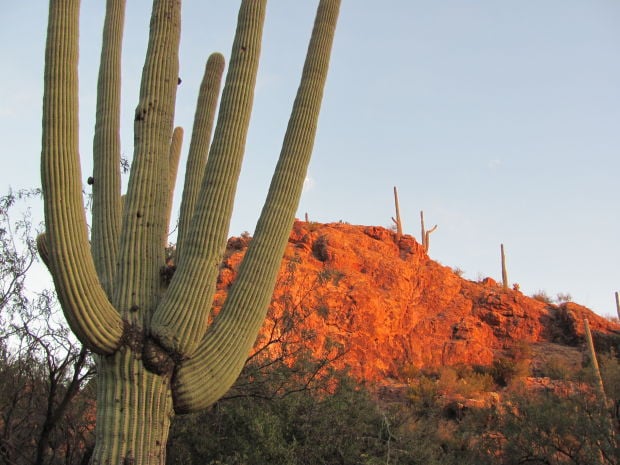Peer up from lower reaches of Ventana Canyon near the end of a late-autumn day and here’s what you’re likely to see: a fiery glow.
That red glow on the canyon’s sheer rock walls comes not from an actual fire — but from the almost magical sunlight that illuminates the canyon at sunset in this season.
“Unbelievable,” said one hiker on observing the light show one day recently along the Ventana Canyon Trail in the Catalina Mountains north of Tucson.
“Heavenly,” said another.
Many canyons of the Catalinas — Sabino Canyon and Pima Canyon among them — catch brilliant rays at the end of the day. But the orientation, topography and rock formations of Ventana Canyon seem to make it special, many hikers agree.
“One of the things that is special about Ventana Canyon is that it is a north-south canyon,” said Sam McClung, president of the Southern Arizona Hiking Club. “That means as the afternoon sun shines over Tucson, the sun has ‘set’ over Ventana Canyon. There is early twilight, and the birds begin their nightfall songs. The shadows creep up the eastern wall, with the sun casting a red-orange glow over the high walls.
“In the canyon, the hiker feels the nighttime approaching much more slowly than most other places, since the light after the canyon sunset lingers for hours,” McClung said. “An inexperienced hiker can think that they are about to run out of daylight when, in fact, there are hours of daylight left. Most experienced hikers, on their way out of the canyon, get quiet, in part because of their tiredness, but also because the light in the space is special.”
Pat Hammes, a hiker who serves as the hiking club’s store manager, said, “George Costanza, of ‘Seinfeld’ (TV show) fame, described the late-afternoon light as a ‘pinkish hue’ — which is so very apparent in our surrounding mountains and canyons.”
SUNSET LIGHT FACTORS
Fiery red sunset light, as well as golden hues, can result from several factors including the low angle of late-day sunlight, the position of the sun in the southern sky during late fall and winter, and pollutants in the air.
An online publication of the National Oceanic and Atmospheric Administration notes that “at sunrise or sunset, sunlight takes a much longer path through the atmosphere than during the middle part of the day. Because this lengthened path results in an increased amount of violet and blue light being scattered out of the beam by the nearly infinite number of scattering ‘events’ that occur along the way (a process collectively known as multiple scattering), the light that reaches an observer early or late in the day is noticeably reddened.”







